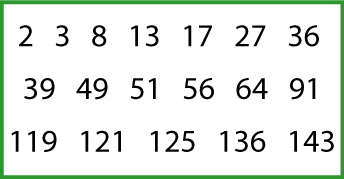Or search by topic
Number and algebra
Geometry and measure
Probability and statistics
Working mathematically
Advanced mathematics
For younger learners
Number Families



- Problem
- Getting Started
- Student Solutions
- Teachers' Resources
Why do this problem?
This problem gives students plenty of opportunity to explore and discuss patterns and properties of numbers. It would make a great starter activity as a prelude to some in-depth work on Factors, Multiples and Primes.
Possible approach

Show students the image above from the problem, or display this slide.
"From this set of numbers, can you find four or more that belong together?
Write down your set of numbers and a sentence to explain why they go together."
Give students a short while to find a set, and then collect together examples of sets on the board. You could invite students to tell you their four (or more) numbers and then ask the rest of the class to suggest the rule that describes the set.
A possible homework task could be to come up with as many different sets as possible, together with explanations.
Possible support
Students could start by listing as many properties of each number as they can, and then look for numbers which have the same property.
Possible extension
Students could then have a go at the Factors and Multiples Puzzle, Dozens and Shifting Times Tables
You may also like
Gaxinta
A number N is divisible by 10, 90, 98 and 882 but it is NOT divisible by 50 or 270 or 686 or 1764. It is also known that N is a factor of 9261000. What is N?
Thirty Six Exactly
The number 12 = 2^2 × 3 has 6 factors. What is the smallest natural number with exactly 36 factors?
Strange Numbers
All strange numbers are prime. Every one digit prime number is strange and a number of two or more digits is strange if and only if so are the two numbers obtained from it by omitting either its first or its last digit. Find all strange numbers.

